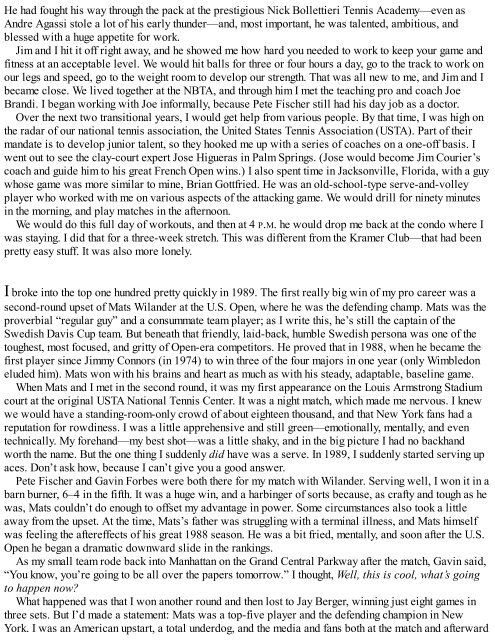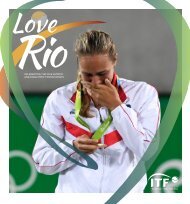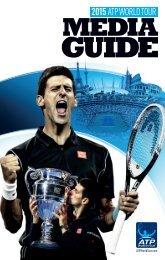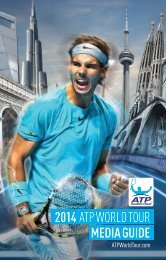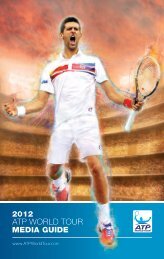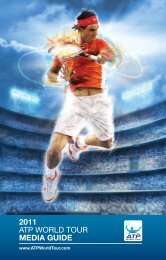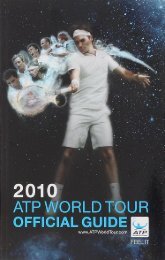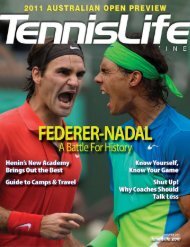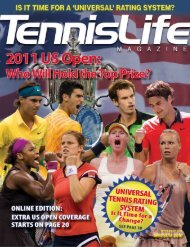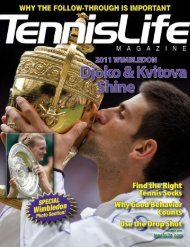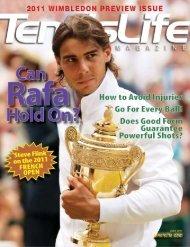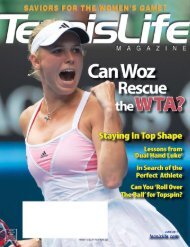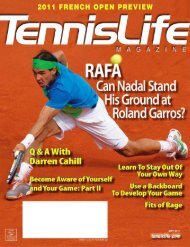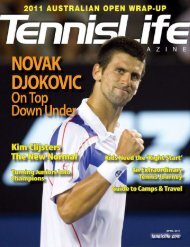A Champion's Mind - Pete Sampras
www.tennismoscow.me Insta:TENNISMOSCOW
www.tennismoscow.me Insta:TENNISMOSCOW
You also want an ePaper? Increase the reach of your titles
YUMPU automatically turns print PDFs into web optimized ePapers that Google loves.
He had fought his way through the pack at the prestigious Nick Bollettieri Tennis Academy—even as<br />
Andre Agassi stole a lot of his early thunder—and, most important, he was talented, ambitious, and<br />
blessed with a huge appetite for work.<br />
Jim and I hit it off right away, and he showed me how hard you needed to work to keep your game and<br />
fitness at an acceptable level. We would hit balls for three or four hours a day, go to the track to work on<br />
our legs and speed, go to the weight room to develop our strength. That was all new to me, and Jim and I<br />
became close. We lived together at the NBTA, and through him I met the teaching pro and coach Joe<br />
Brandi. I began working with Joe informally, because <strong>Pete</strong> Fischer still had his day job as a doctor.<br />
Over the next two transitional years, I would get help from various people. By that time, I was high on<br />
the radar of our national tennis association, the United States Tennis Association (USTA). Part of their<br />
mandate is to develop junior talent, so they hooked me up with a series of coaches on a one-off basis. I<br />
went out to see the clay-court expert Jose Higueras in Palm Springs. (Jose would become Jim Courier’s<br />
coach and guide him to his great French Open wins.) I also spent time in Jacksonville, Florida, with a guy<br />
whose game was more similar to mine, Brian Gottfried. He was an old-school-type serve-and-volley<br />
player who worked with me on various aspects of the attacking game. We would drill for ninety minutes<br />
in the morning, and play matches in the afternoon.<br />
We would do this full day of workouts, and then at 4 P.M. he would drop me back at the condo where I<br />
was staying. I did that for a three-week stretch. This was different from the Kramer Club—that had been<br />
pretty easy stuff. It was also more lonely.<br />
I broke into the top one hundred pretty quickly in 1989. The first really big win of my pro career was a<br />
second-round upset of Mats Wilander at the U.S. Open, where he was the defending champ. Mats was the<br />
proverbial “regular guy” and a consummate team player; as I write this, he’s still the captain of the<br />
Swedish Davis Cup team. But beneath that friendly, laid-back, humble Swedish persona was one of the<br />
toughest, most focused, and gritty of Open-era competitors. He proved that in 1988, when he became the<br />
first player since Jimmy Connors (in 1974) to win three of the four majors in one year (only Wimbledon<br />
eluded him). Mats won with his brains and heart as much as with his steady, adaptable, baseline game.<br />
When Mats and I met in the second round, it was my first appearance on the Louis Armstrong Stadium<br />
court at the original USTA National Tennis Center. It was a night match, which made me nervous. I knew<br />
we would have a standing-room-only crowd of about eighteen thousand, and that New York fans had a<br />
reputation for rowdiness. I was a little apprehensive and still green—emotionally, mentally, and even<br />
technically. My forehand—my best shot—was a little shaky, and in the big picture I had no backhand<br />
worth the name. But the one thing I suddenly did have was a serve. In 1989, I suddenly started serving up<br />
aces. Don’t ask how, because I can’t give you a good answer.<br />
<strong>Pete</strong> Fischer and Gavin Forbes were both there for my match with Wilander. Serving well, I won it in a<br />
barn burner, 6–4 in the fifth. It was a huge win, and a harbinger of sorts because, as crafty and tough as he<br />
was, Mats couldn’t do enough to offset my advantage in power. Some circumstances also took a little<br />
away from the upset. At the time, Mats’s father was struggling with a terminal illness, and Mats himself<br />
was feeling the aftereffects of his great 1988 season. He was a bit fried, mentally, and soon after the U.S.<br />
Open he began a dramatic downward slide in the rankings.<br />
As my small team rode back into Manhattan on the Grand Central Parkway after the match, Gavin said,<br />
“You know, you’re going to be all over the papers tomorrow.” I thought, Well, this is cool, what’s going<br />
to happen now?<br />
What happened was that I won another round and then lost to Jay Berger, winning just eight games in<br />
three sets. But I’d made a statement: Mats was a top-five player and the defending champion in New<br />
York. I was an American upstart, a total underdog, and the media and fans both at the match and afterward


